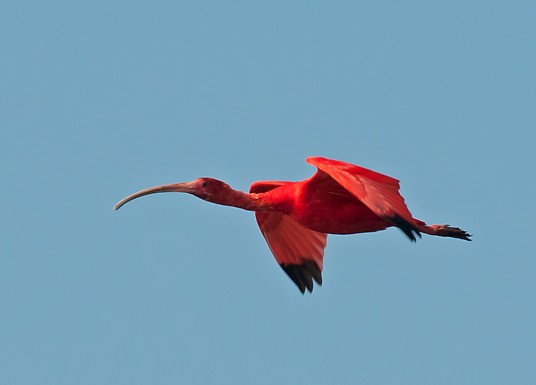Scarlet Ibis
A species of American White and Scarlet Ibises Scientific name : Eudocimus ruber Genus : American White and Scarlet Ibises
Scarlet Ibis, A species of American White and Scarlet Ibises
Botanical name: Eudocimus ruber
Genus: American White and Scarlet Ibises
Content
Description People often ask General Info
 Photo By Dario Sanches , used under CC-BY-SA-2.0 /Cropped and compressed from original
Photo By Dario Sanches , used under CC-BY-SA-2.0 /Cropped and compressed from original Description
The scarlet Ibis is a large, striking bird with vibrant red plumage. Found in wetlands and mangroves, it feeds on crustaceans, insects, and mollusks. It is a social bird, nesting in colonies and engaging in group foraging behavior. This species is native to South America and the Caribbean but has also been spotted in Florida and Louisiana. Its call is a loud, guttural croak, often given in chorus with other colony members. 
Size
55-70 cm (21.5-27.5 in)
Colors
Black
Red
Life Expectancy
16 years
Nest Placement
Tree
Feeding Habits
Scarlet Ibis primarily feeds on insects, particularly scarabs and ground beetles, while also consuming shrimp, small crabs, and mollusks. This bird forages by probing mud with its long bill, often stealing food from other species and following livestock to catch disturbed insects. Its red plumage is maintained by the carotenoid astaxanthin, found in shellfish or supplemented in captivity with beetroot and carrot.
Habitat
Scarlet Ibis predominantly inhabits varied wetland ecosystems. Their range extends across tropical and subtropical regions with a strong preference for marshy environments such as mangrove swamps, tidal mudflats, and estuaries. Additionally, scarlet Ibis frequents freshwater habitats including marshes, shallow lakes, and sewage ponds, as well as human-altered landscapes like fish ponds and rice fields. Nesting typically occurs in mangrove islands or in shrubbery near inland wetlands, suggesting an ecological reliance on both coastal and freshwater ecosystems.
Dite type
Piscivorous
People often ask
General Info
Feeding Habits
Bird food type
Behavior
The scarlet ibis is a sociable and gregarious bird, and very communally-minded regarding the search for food and the protection of the young. They live in flocks of thirty or more. Members stay close, and mating pairs arrange their nests in close proximity to other pairs in the same tree. For protection, flocks often congregate in large colonies of several thousand individuals. They also regularly participate in mixed flocks, gaining additional safety through numbers: storks, spoonbills, egrets, herons and ducks are all common companions during feedings and flights. 
Distribution Area
The range of the scarlet ibis is very large, and colonies are found throughout vast areas of South America and the Caribbean islands. Native flocks exist in Brazil; Colombia; French Guiana; Guyana; Suriname; and Venezuela, as well as the islands of the Netherlands Antilles, and Trinidad and Tobago. Flocks gather in wetlands and other marshy habitats, including mud flats, shoreline and rainforest. There is an outlying colony in the Santos-Cubatão mangroves of Baixada Santista district in southeastern Brazil, which is considered critically endangered. The highest concentrations are found in the Llanos region between western Venezuela and eastern Colombia. The fertile and remote tropical grassland plain of the Llanos provides a safe haven far from human encroachment. Together with its relative the bare-faced ibis, the scarlet ibis is remarkably prolific and conspicuous in the region. Scarlet ibis vagrants have been identified in Belize, Ecuador, and Panama; Aruba, Cuba, Dominica, Grenada, and Jamaica; sightings have even been made in the United States. The species may well have been a natural vagrant to the Gulf Coast in the 19th century or earlier – in The Birds of America, John James Audubon made brief remarks regarding three rubra specimens he encountered in Louisiana. However, virtually all modern occurrences of the species in North America have been introduced or escaped birds. In one notable example from 1962, scarlet ibis eggs were placed in white ibis nests in Florida's Greynolds Park, and the resulting population hybridised easily, producing "pink ibises" that are still occasionally seen. 
Species Status
Not globally threatened.
Scientific Classification
Phylum
Chordates Class
Birds Order
Pelicans and Relatives Family
Ibises and spoonbills Species
Scarlet Ibis